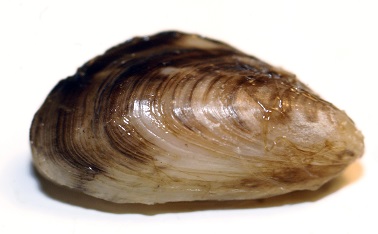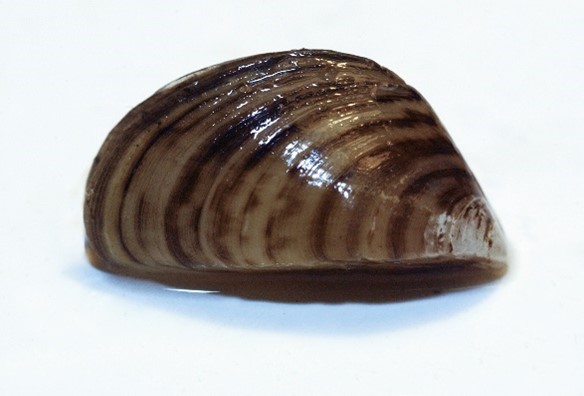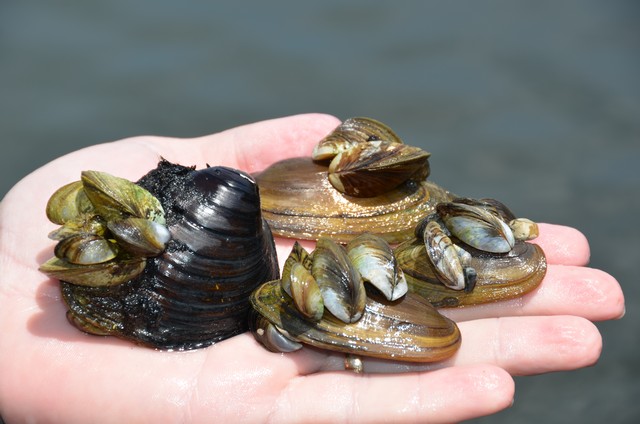Quagga Mussel
Dreissena bugensis
Report it
If you think you have found an aquatic invasive species:
- do not return the species to the water
- take photos
- note:
- the exact location (GPS coordinates)
- the observation date
- identifying features
- contact us to report it
Learn about the Quagga mussel, including their identifying features, distribution, habitat, spread, similar species, impacts and our response.
On this page

Quagga Mussel (Photo credit: Dave Brenner, Michigan Sea Grant)
Identifying features
- round, including its ventral surface
- up to 3 cm, average of 2 cm long
- lighter colour than the Zebra Mussel, with dark concentric rings
If you think you have seen a Quagga Mussel, report it.
Where is the species invasive
The Quagga Mussel was introduced to the Great Lakes via ballast water released from commercial shipping vessels, before spreading into the St. Lawrence River and most of the Northeastern U.S. waterways in the late 1980s. It is now found throughout the southern Great Lakes and Lake Simcoe in Ontario.
Distribution
The Quagga Mussel is native to the Caspian and Black Sea regions.
Habitat
The Quagga Mussel lives in freshwater or low salinity environments. It is observed on rocky and sandy bottoms or covered with aquatic vegetation. It is found in deeper waters than the Zebra Mussel (as deep as 100 m), where temperatures are cooler and the waters are still or calm.
Similar species
The Quagga Mussel is a freshwater bivalve that resembles the Zebra Mussel (Dreissena polymorpha), both in morphology and ecologically. The Quagga Mussel differs from the Zebra Mussel in that it is larger, rounder and wider. Both invasive species live in the same habitat as native freshwater mussels, including 23 species of freshwater mussels within the Unionidae and Margaritiferidae families. Native mussels can be easily differentiated from the invasive mussels because they are 3 to 4 times the size of the invaders. Native mussel shells are more oval, and they are usually greenish or dark brown, with visible growth rings.
Zebra Mussel

Photo credit: Dave Brenner, Michigan Sea Grant
Invasive mussels on native mussels

Photo credit: Todd J. Morris
Impacts
Ecological impacts
Like Zebra Mussels, Quagga Mussels can have significant negative impacts on freshwater habitats by out-competing native species for food. This affects the composition of other communities within the ecosystems. They can alter food webs by removing the native species' food sources, such as plankton. By completely covering rocks, Quagga Mussels can affect fish spawning areas, which impacts the survival of fish eggs. Quagga Mussels can also clear water allowing sunlight to penetrate deeper in the water column, increasing the growth of submerged aquatic vegetation. They are also selective feeders which means they often choose not to feed on toxic algae, sometimes causing or worsening toxic algal blooms.
Quagga Mussels also harm native mussels, many of which are species at risk. They outcompete these species for food and will attach themselves to native mussels, suffocating them.
Females can release up to one million eggs each season which enhances the natural dispersion of this species from locations where it is introduced.
Socio-economics impacts
Quagga Mussels cause millions of dollars in damage every year to boat engines, power plants and public water intakes by fouling infrastructure, blocking water flow. Removal of mussels from affected structures is both time consuming and costly.
Response
The Identification Booklet of Freshwater Invasive Species in Quebec from DFO is available to make the detection of the Quagga Mussel easier.
The best way to protect water bodies from this invader is to properly clean, drain and dry boats and other equipment used in nautical and recreational fishing activities. Follow the clean-up steps described on the DFO Aquatic Invasive Species Prevention page. Always check and follow provincial regulations when planning to move water-based craft and equipment.
Related links
- Zebra mussel and Quagga mussel identification photos and characteristics
- Science Advice on "Clean, Drain, Dry and Decontaminate" treatments and protocols to prevent the introduction and spread of aquatic invasive species (PDF, 632 KB)
- Research Document on "Clean, Drain, Dry, and Decontaminate" treatments and protocols to prevent the introduction and spread of aquatic invasive species
- Risk Assessment for Three Dreissenid Mussels (Dreissena polymorpha, Dreissena rostriformis bugensis, and Mytilopsis leucophaeata) in Canadian Freshwater Ecosystems
- Date modified: